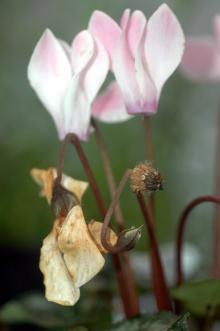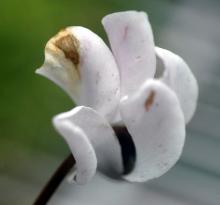See:
Greenhouse Plants, Ornamental - Gray Mold
Cause Botrytis cinerea (sexual: Botryotinia fuckeliana), a fungus that colonize senescent, dead, dying, or wounded plant parts. Naturally senescing leaves are readily infected. From these infections they can attack healthy tissues. A moist, humid environment is ideal for pathogen sporulation and spread. Initial infections follow a buildup of inoculum on dead and senescing leaves within the canopy. One sufficient inoculum has been released, healthy leaves and flower can be infected. Petioles are often infected followed by adjacent healthy tissues. Conidia may come from sources in and outside the greenhouse. The fungus is everywhere plants are grown and has a wide host range. Shipping and storage conditions that result in the presence of ethylene (such as with fruit) can increase disease.
This fungus may be seedborne and grow systemically in the plant without producing symptoms until flowering and/or senescence.
Symptoms The petiole base and flower stalks may rot and may eventually cause whole portions of the plant to collapse. Then the characteristic grayish brown spores of the fungus cover infected tissue. May be confused initially with Fusarium wilt or bacterial soft rot. Petals develop water-soaked flecks that grow into tan necrotic spots. An intense color may form around lesions on colored petals. Spots on dark-flowered cultivars are often white while on colored flowers they are dark-pink-to-red.
Cultural control
- Remove all dead and dying plant parts (particularly blossoms) on and around plants and take them out of the greenhouse. Take care not to injury healthy plants in this process.
- Maintain a steady, relatively dry environment by keeping greenhouse humidity below 90%, increasing spacing between plants for good air circulation, and taking care not to splash water on foliage during watering. Heating the greenhouse at night (especially for zero or negative DIF) or venting around sunset may be necessary. Heating in the morning before sunup can also help prevent dew formation as air temperature increases faster than the temperature of plant parts. If using DROP or DIP for size control, do not let humidity rise above 90%.
- Using subirrigation systems can also help reduce canopy humidity.
- Spacing plants also allows better light penetration, reducing senescence of the lower leaves and thus helping reduce the amount of highly susceptible plant tissue.
- Place fans in greenhouse to get better air circulation.
- When shipping, use paper not plastic sleeves around plants.
- The use of ethylene blockers (such as EthylBloc) before shipping may be helpful.
Chemical control Best when used with cultural controls. Tank-mix and/or alternate products from different groups with different modes of action to prevent the buildup of resistant fungi. Limit any one group during the growing season.
- Affirm WDG at 0.25 to 0.5 lb/100 gal water. Group 19 fungicide. 4-hr reentry.
- Astun at 10 to 17 fl oz/100 gal water. Group 7 fungicide. 12-hr reentry.
- Chipco 26019 FLO at 1 to 2.5 quarts/100 gal water. Group 2 fungicide. 12-hr reentry.
- Decree 50 WDG at 0.75 to 1.5 lb/100 gal water. Group 17 fungicide. 12-hr reentry.
- Medallion WDG at 2 to 4 oz/100 gal water. Use with oils or adjuvants may damage plant. Group 12 fungicide. 12-hr reentry.
- Mural at 4 to 7 oz/100 gal water. Group 7 + 11 fungicide. 12-hr reentry.
- Orkestra at 8 fl oz/100 gal water. Group 7 + 11 fungicide. 12-hr reentry.
- Orkestra at 8 to 10 fl oz/100 gal water. Group 7 + 11 fungicide. 12-hr reentry.
- Pageant at 12 to 18 oz/100 gal water. Do not use with organosilicone-based adjuvant. Group 7 + 11 fungicide. 12-hr reentry.
- Palladium at 4 to 6 oz/100 gal water. Avoid excessive runoff to small plants, which may result in stunting and/or chlorosis. Group 9 + 12 fungicide. 12-hr reentry.
- Phyton 27 at 1.5 to 2 fl oz/10 gal water. Group M1 fungicide. 48-hr reentry.
- Spirato GHN at 2 to 4 fl oz/100 gal water. Use with oils or adjuvants may cause plant damage. Group 12 fungicide. 12-hr reentry.
- Terraguard SC at 4 to 8 fl oz/100 gal water. Group 3 fungicide. 12-hr reentry.
- Ziram 76 DF at 1.5 to 2 lb/100 gal water. Group M3 fungicide. 48-hr reentry.
Biological control
- LALStop G46 WG (Clonostachys rosea [formerly Gliocladium catenulatum] strain J1446) at 0.13 oz/1 gal water. Do not use with other products in the tank. 4-hr reentry. O
References Barnes, S.E., and Shaw, M.W. 2003. Infection of commercial hybrid primula seed by Botrytis cinerea and latent disease spread through the plants. Phytopthology 93:573-578.
Kohl, J., Gerlagh, M., De Haas, B.H., and Krijger, M.C. 1998. Biological control of Botrytis cinerea in cyclamen with Ulocladium atrum and Gliocladium roseum under commercial growing conditions. Phytopathology 88:568-575.




